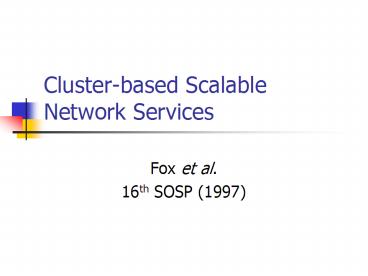Clusterbased Scalable Network Services PowerPoint PPT Presentation
1 / 18
Title: Clusterbased Scalable Network Services
1
Cluster-based Scalable Network Services
- Fox et al.
- 16th SOSP (1997)
2
General Comments
- Really an experiential or reporting paper
- Recall the context 1997
- Dialup broadband
- Internet boom
- Dell
- Reverse-architecture from HotBot
3
COW preferable to Big Iron?
- Scalability
- Grain size of network apps more appropriate to
COW - Remember the problem domain! - Replace capacity planning with reactionary
incremental scaling - Availability
- Single HW failure not fatal
- Cost effectiveness
- Commodity building blocks make expansion
easy/efficient
4
Challenges for COW
- Administration
- Frequently biggest headache, but they dont
really address it - Matching SW scaling to HW scaling
- HW unit of scaling is a PC component-ize SW to
match - Partial failures?
- Shared state?
5
ACID semantics
- ACID database model
- Atomicity all or nothing
- Consistency only valid data written to
database, only consistent database states
allowed - Isolation (serialization) simultaneous
transactions dont affect one another - Durability no transaction is ever lost -
database is always consistent - Preferable for services to be unavailable rather
than to perform inconsistently - Claim ACID is overkill for network applications
6
BASE semantics
- Basically available, soft state, eventual
consistency - Service is always available although data may be
inexact - Regenerate instead of store data
- Focus on performance approximate/quick data vs.
exact/slow - Trades consistency for simplicity of
implementation - They target applications that deal with BASE
data
7
Scalable Network Services
Graphical Monitor
WAN
Manager
System Area Network
User Profile DB
Worker API
8
SNS layering
- 3 layers
- SNS implementation
- TACC Transformation, aggregation, caching,
customization - Service-specific (user interface, device-specific
presentation)
9
SNS Layer
- Scalability through replication
- Workload (grain size) makes this approach
feasible - Component-based code, simple workers
- Resource needs scale linearly with load
- Centralized load balancing w/overload pool
- Fault-tolerance via process peers
- Stub code simplifies workers
10
TACC programming model
- Transformation changing data content
(filtering, encryption, compression) - Aggregation collecting/collating data
- Customization user preferences (again, recall
the context) - Caching storing data cheaper than moving it
- Claims
- Many interesting services can be implemented
entirely at TACC layer - Of those, few will need SNS-level mods
11
TranSend
- Web distillation proxy deployed at Berkeley
- HTTP front ends
- Workers are distillers (JPEG filters)
- Exploits user preferences and cached data
12
Load balancing in TranSend
- All components subscribe to manager via IP
multicast beacon - Manager matches requests with available/appropriat
e workers - Worker stubs report load information to manager
- Manager computes new load-balances, beacons them
to manager stubs at front-ends - Mgr. stubs cache load info in case manager dies
13
Fault-tolerance in TranSend
- All components register with manager
- Manager detects broken connections, uses
timeouts - All soft state is beaconed
- All processes have peers which restart them if
necessary (in manager stub code)
14
Workers in TranSend
- Two groups of worker processes
- Cache workers process requests from an object
cache - Distillers perform scaling and filtering on JPEG
images, add user-specified markup
15
Exploiting BASE
- Cached (stale) data avoids communications with a
dead source - Soft state can be regenerated, therefore no need
for transactional commit - Approximate answers (no distillation or cached
data) can be used when system is heavily loaded
or workers unavailable - Approximate/quick vs. exact/slow
16
Experimentation
- 20-million-request HTTP trace used
- Size distribution of image requests drives 1KB
distillation cutoff - Characterized request capacity per worker
- Worker performance scales roughly linearly with
input size - Load balancing
- Need to balance H (load avg at which new worker
is spawned) and D (new worker uptake interval) - Soft state was originally too soft
17
Scalability
- Start with minimal system
- Increase load until some component saturates
- Add resources
- Lather, rinse, repeat
- Results
- System grown nearly linear
- Scaling limited by incoming bandwidth, not SAN
- As SAN saturates, multicast (unreliable) traffic
is dropped and load balancing scheme fails
18
Take-home ideas
- A good example of growing a framework from an
existing implementation (HotBot) - Hitting the sweet spot SW component size, HW
scalability increment, work request size all
match - Providing useful services where BASE model holds
- Detailed characterization of system behavior
- Always helps to have a real workload trace

